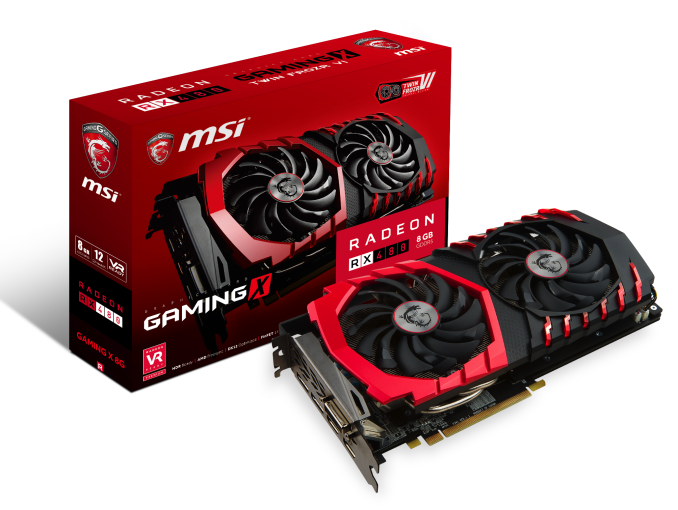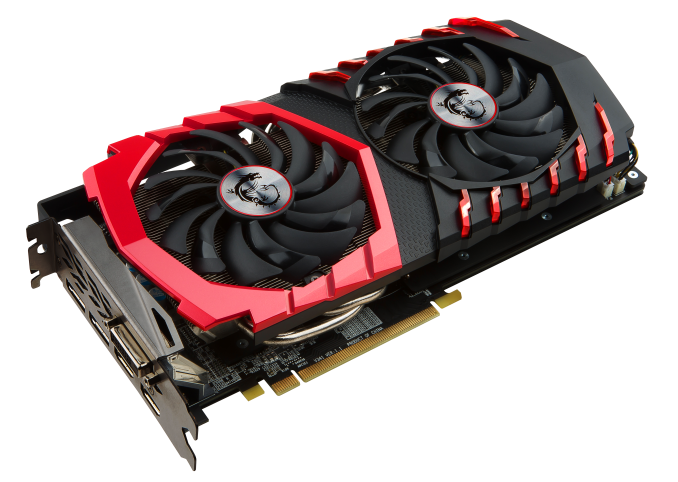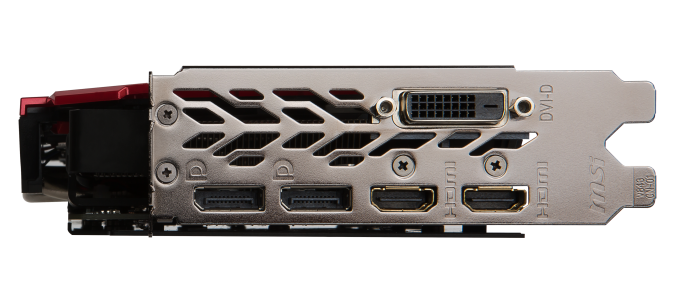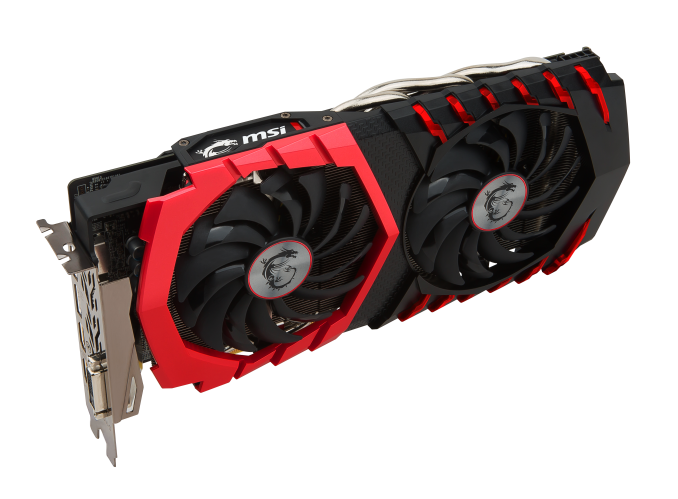MSI Shows New Radeon RX 480 Gaming Cards, with an 8-pin
by Daniel Williams on July 26, 2016 10:30 AM EST
Today MSI is announcing the latest entry in the Gaming X GPU line with the Radeon RX 480 Gaming X 8G/4G cards as well as non-X variants. The main difference between the non-X and X cards is in the core and memory frequencies, with the X card having the higher performance. In return, there will be a small price difference between the two variants.
| MSI Radeon RX 480 Gaming Specification Comparison | |||||||
| GAMING X 8G | GAMING X 4G | GAMING 8G | GAMING 4G | ||||
| Core Clock |
Silent | 1266 MHz | |||||
| Gaming | 1303 MHz | 1279 MHz | |||||
| OC Mode | 1316 MHz | 1292 MHz | |||||
| Memory Clock (Reg/OC) | 8.0/8.1 Gbps GDDR5 | 8.0 Gbps GDDR5 | |||||
| VRAM | 8 GB | 4 GB | 8 GB | 4 GB | |||
| Launch Date | TBD Mid August 2016 | ||||||
| Launch Price | Unknown ??? | ||||||
Starting with appearance, all four models shown today feature an angular, aggressive, red and black design for the cooler, which glows through the red highlights. On the side of the card is an MSI logo lit by customizable RGB lighting which is adjusted through the MSI Gaming software bundled with the card. Around back there is a full cover back plate on the Gaming X cards, and moving back around to the cooler we have two large fans over a full-length cooler and PCB. Running through the heatsink are three heat pipes at 8mm thick each. These heat pipes are squared off at the bottom and mated to a nickel-plated copper baseplate, aiming to increase contact with the GPU core and hence increase heat transfer. This cooler is toned down from that used on the highest end cards, but should still make for a very capable cooling solution.
Moving from form over to function, MSI’s RX 480 Gaming X cards are built from what MSI calls “Military Class 4” components, which is marketing speak for their choosing quality components to assemble this card. For power, the cards have a single 8-pin connector, and for the output we have two HDMI, two DisplayPort, and one DVI-D connection. This appears to be a very popular arrangement this generation, allowing one HDMI port for a monitor and another for a VR headset. MSI also use their TORX Fan 2.0 design which they say will generate 22% more air pressure, and like other Gaming and Gaming X cards the fans will shut off at temperatures below 60C. If true these fans coupled with the Twin Frozr VI heatsink could do an admirable job of quietly handling any heat an RX 480 can muster. For performance numbers on the Gaming X, we have a moderate clock speed gain over the reference card in OC mode, while the memory is bumped up to 8.1 Gbps in OC mode.
With no word on pricing, both 8GB and 4GB versions of the MSI Radeon RX 480 Gaming X are expected to be in stores worldwide around the middle of August 2016.



















34 Comments
View All Comments
Geranium - Tuesday, July 26, 2016 - link
TSMC's 16nm aren't good either and is mainly desinged for SoC in mind. It hitting very high MHz doesn't mean it is very good. GloFo's 32nm SOI can also hit very high MHz.Morawka - Tuesday, July 26, 2016 - link
i havent seen one negative thing about TSMC's 16nm process here lately. When you have a GTX 1060 pulling so little power, but giving you gtx 980 performance, i'd say it's a pretty good node shrink.BurntMyBacon - Wednesday, July 27, 2016 - link
Defect rates?BurntMyBacon - Wednesday, July 27, 2016 - link
@Geranium: "TSMC's 16nm aren't good either and is mainly desinged for SoC in mind."You'll have to describe what you mean by not very good. Though I think you are correct in saying the current process was initially designed for SoCs, like most foundries, TSMC designs multiple processes at a node with differing power and performance characteristics to address different markets.
@Geranium: "It hitting very high MHz doesn't mean it is very good."
So tell us what makes it bad. It certainly isn't clock rates. Power consumption and leakage characteristics look good as well. Switching thresholds, rise times, and fall times have to be good to achieve high clocks. Capacitance characteristics have to be reasonably good or they would negatively effect rise and fall times (clocks). You could perhaps call it inferior in the sense that the transistor size / density doesn't meet Intel's definition of 16nm/14nm, but neither does Samsung or Global Foundries. The only legitimate issue that I know the process has is defect rates. Given the same number of defects per wafer, smaller chips will have better yields. Low yields for relatively large (compared to SoCs) chips could be contributing to the current lack of supply. That said, this is not an unexpected factor when moving to a new process and, thus far, there is nothing to indicate abnormally low yields this early on in the process life cycle.
@Geranium: "GloFo's 32nm SOI can also hit very high MHz."
It also had good power consumption and leakage characteristics compared to other 32nm / 28nm processes. The process is generally considered a good process. It just gets compared with Intel's 22nm and 14nm 3D transistor processes. Even discounting the power and frequency gains, it clearly doesn't have the transistor density to compare. The "doxer" architectures used to show off the process doesn't do it any favors either.
extide - Tuesday, July 26, 2016 - link
Well, honestly, OC mode on cards like this always only add a few Mhz. You can always overclock it further yourself, and I would be we will see 1400+ Mhz on cards like this.chlamchowder - Tuesday, July 26, 2016 - link
That cooler looks like overkill for a 150W card that doesn't overclock well.Personally, I'd like to see a better blower cooler implementation from AIBs - one with a more substantial fin stack, and maybe heatpipes or a vapor chamber. That should cool the card well while cleanly exhausting all heat out the back.
Mr Perfect - Tuesday, July 26, 2016 - link
I'd go for a quality blower too, SFF cases don't need to be dealing with all that heat. I doubt that monster PCBs like that MSI will even fit in a SFF case though...Death666Angel - Tuesday, July 26, 2016 - link
"card that doesn't overclock well."So how many of these unreleased cards have you had a chance to test in OC scenarios, yet?
extide - Tuesday, July 26, 2016 - link
I think ASUS has a blower-fan version of the RX480 coming out. Not sure how good it is, but def worth a look.Mr Perfect - Tuesday, July 26, 2016 - link
I'm curious to see how that one fares in reviews. Someone was saying that in the past, Asus has used a plain extruded aluminum block in their cheap blower cards. No heatpipes, no fin stacks, just a block of metal, '90s style. Hopefully that's not the case with current cards.